The Cold North Wind: The autumn of 1967 saw the end of steam on the Eastern Region and at the great railway centre of Crewe.
BR also introduced a ban on privately-owned steam engines. Brian Sharpe recounts not only how BR’s steam operations rapidly contracted as the final curtain approached but also how many now-famous locomotives were being saved.
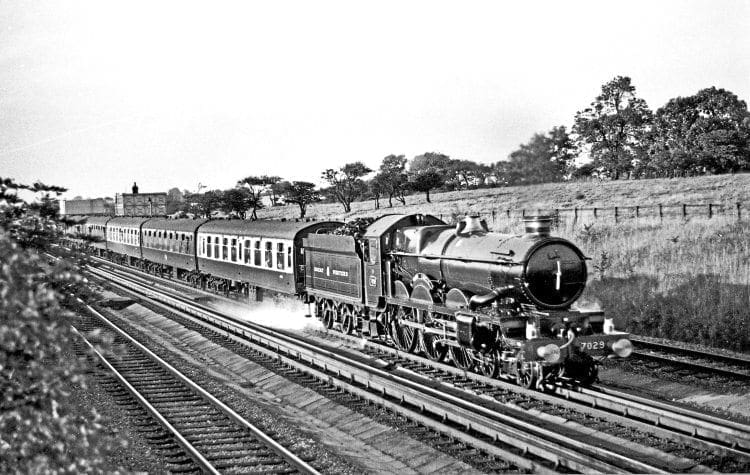
In July 1967, the Bulleid Pacifics bowed out on the South Western main line and the last steam engines on the Scottish Region; NBR J36 0-6-0s Nos. 65288 and 65345 dropped their fires. At the end of August, the Settle & Carlisle line said goodbye to the Jubilees and by the end of September steam had virtually disappeared from the Eastern Region.
The Eastern and North Eastern regions had merged in 1966 and while steam ended in the North East on September 9, 1967, a handful of West Riding sheds retained a steam allocation into October. Holbeck still had Jubilees Nos. 45562 Albertaand 45593 Kolhapuron its books as well as a few ‘Black Fives’, of which No. 45428 emerged as something of a star, leading to its purchase for preservation on withdrawal, along withKolhapur.

A number of Fairburn 4MT 2-6-4Ts remained active up to the end of September, their duties including the short Bradford portions of King’s Cross to Leeds and Bradford expresses, including even the ‘Yorkshire Pullman’.
Bradford’s former L&Y shed at Low Moor found itself with the last three LNER B1 4-6-0s in BR service; Nos. 61030 Nyala,61306 and 61337 and No. 61306 was given the honour of hauling the last steam-hauled Pullman on September 30.
No. 61306 was also fortunate enough to be purchased for preservation and was moved to Carnforth along with two of the Fairburn tanks; Nos. 42073 and 42085; the tanks being destined for the Lakeside & Haverthwaite Railway.
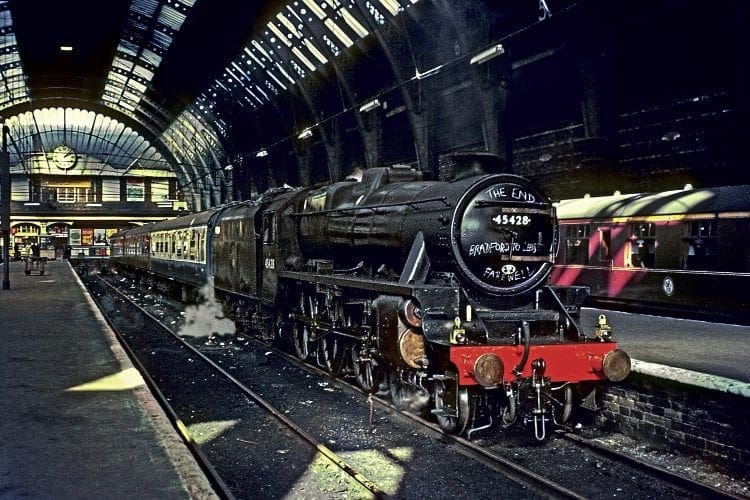
Fairburn tank No. 42152 hauled the very last ER passenger train, the 4.18pm Bradford to Leeds on October 1, touching 74mph in the process. A large class of well-known locomotives, which was rendered extinct by November 1967, was the WD Austerity 2-8-0, and no-one even thought of preserving any.
Also by The Railway Hub:
The last BR steam in the East Midlands, LMS 3F 0-6-0Ts Nos. 47289, 47383 and 47629 were withdrawn on October 7 after a period on hire to the NCB, working at Williamthorpe colliery. Fortunately No. 47383 was purchased for preservation, becoming a Severn Valley stalwart for many years.
Normanton shed retained servicing facilities for steam and the West Riding continued to see steam arriving from across the Pennines even on passenger workings plus a daily oil train from Heysham headed by a 9F 2-10-0, although usually piloted by a Type 2 diesel.

The end of steam in the Eastern Region left only the London Midland Region still persevering with steam traction. Standard gauge steam preservation was very much in its early days and there was still only the Bluebell Railway running timetabled steam-hauled passenger trains.
BR steam ban
It is common knowledge that BR imposed a ban on main line steam trains. What tends to be forgotten is that the ban applied only to privately-owned steam engines and came into effect not at the end of BR steam but at the end of October 1967 at a time when BR still had plenty of steam engines of its own, which were unaffected. It virtually brought main line steam power to an end outside the North West though.
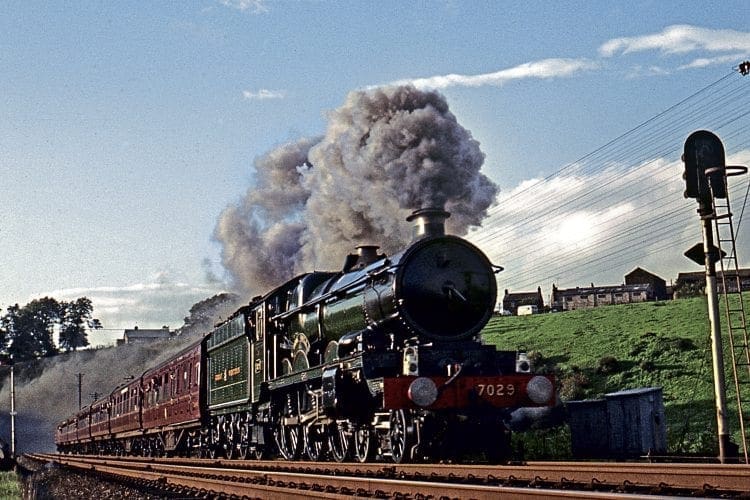
By this time GWR 4-6-0 No. 4079 Pendennis Castle,LNER K4 2-6-0 No. 3442 The Great Marquessand A4 Pacific No. 60009 Union of South Africahad retired after short periods of main line action. This left another GWR 4-6-0; No. 7029 Clun Castle,and two LNER Pacifics; A3 No. 4472 Flying Scotsmanand A4 No. 4498Sir Nigel Gresleyable to participate in what could easily have been the end of preserved steam on the main line. Flying Scotsmanremained exempt from the ban afterwards because of its owner, Alan Pegler’s unique contract with BR.
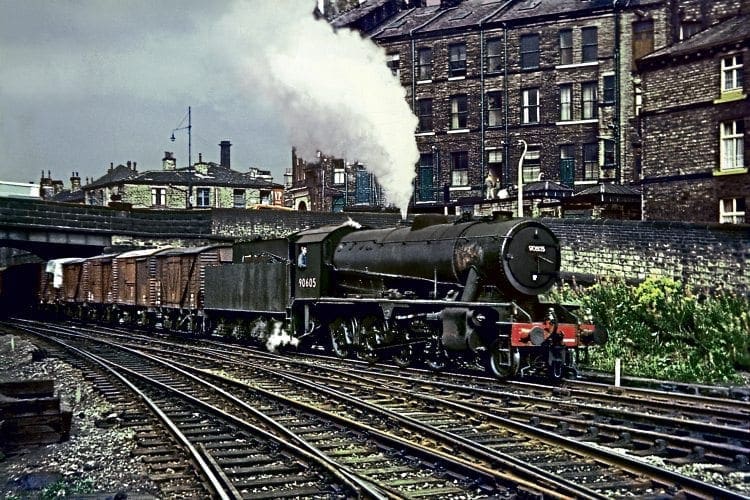
Clun Castlewas the star of the main line preserved steam 60s-style finale and after some clearance tests was able to make runs from Peterborough to Newcastle and to Carlisle, and from King’s Cross to Leeds and York. Scotsmanand Gresleyalso participated in the programme in September and October 1967; the railtours encountering some of the last steam workings in the North East and the West Riding in the course of their travels.
After its surprise appearance on the East Coast Main Line, Clun Castlesaw action on the West Coast Main Line, over Shap no less, and a second visit to the Settle & Carlisle.
A late addition to the select few preserved steam engines that gained approval to run on BR main lines in 1967 was another A4 Pacific, No. 60019 Bittern. This engine, which the previous year had been the last A4 to work for BR, had been purchased by Geoffrey Drury on withdrawal and based at York shed, where occasionally it was used on freight and parcels trains.
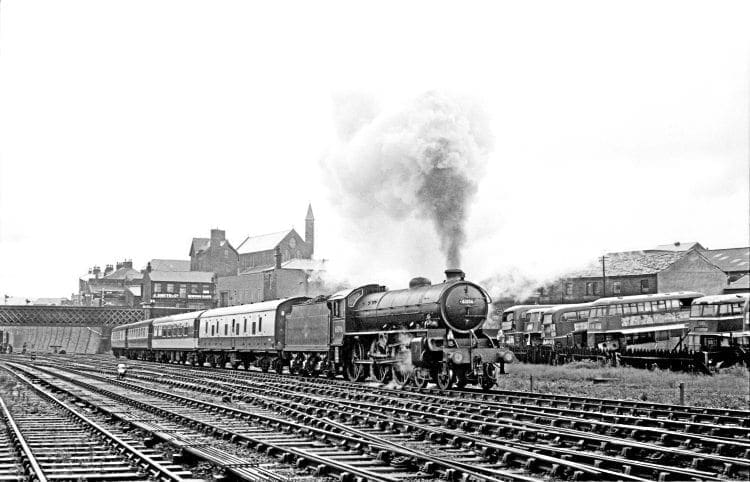
It had made its railtour debut on July 16, 1967 with an RCTS trip from Leeds to Glasgow via the Settle & Carlisle, and banked by a Class 20 diesel over Beattock. Surprisingly its only other excursions came after the BR ban had supposedly come into force, suggesting that it was a hasty decision by BR but that commitments made before the imposition of the ban, would be honoured. Bitternduly headed another RCTS tour, from Leeds to Edinburgh via the ECML on November 4 and the Manchester Rail Travel Society’s ‘Mancunian’ from Leeds to Carnforth and Manchester on November 25, which was advertised as the engine’s last run.
Important railway centre
Crewe is known as one of Britain’s most important railway centres, not only being the convergence of routes from all parts of the country but also for having built many of Britain’s best-known steam engines.
In the heyday of steam, the town boasted two large locomotive sheds; Crewe North and Crewe South. The larger North shed was the passenger depot and South the freight shed. Crewe North closed in 1965, leaving the South shed to cover the remaining steam-hauled passenger workings in the area as well as its freight duties. The line from Manchester had been electrified on September 12, 1960 and from Liverpool on January 1, 1962. Electrification then continued south towards Birmingham and eventually Euston which saw its first main line electric trains in November 1965.
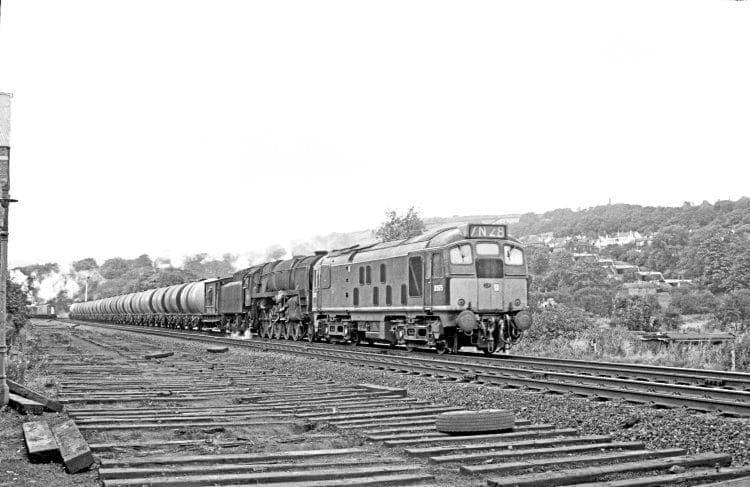
The WCML north from Crewe was not electrified until 1974 and steam continued to work alongside diesel traction on this section during the 1960s. Limited clearances south of Crewe meant that the larger steam engines were not permitted to run under the wires south of Crewe and a yellow diagonal stripe was painted on the cabsides, mainly on LMS express engines as a reminder to the drivers.
With electrification in progress, the WCML never really had the pick of BR’s diesel classes and although a modern diesel locomotive maintenance depot was built south of the station in 1958, even in 1967, diesels were often simply stabled in some sidings north of the station.
The locomotive works had been built in 1840 by the Grand Junction Railway, which also built 200 cottages establishing a new community. The first locomotive built at Crewe went into service in 1843.
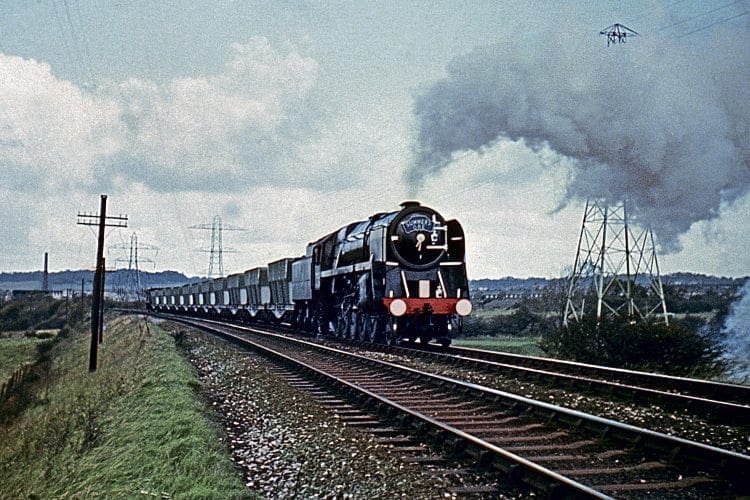
In 1845 the Liverpool & Manchester Railway was merged with the Grand Junction, which then merged in 1846, with the London & Birmingham Railway and the Manchester & Birmingham Railway to form the London and North Western Railway. All four had their own workshops but, in time, the LNWR’s locomotive building was concentrated at Crewe. By 1848 the works employed more than 1000 workers and was producing one locomotive a week.
When the LNWR became part of the LMS in 1923, the new company faced difficulties in managing the incompatibility of the LNWR at Crewe and the Midland Railway at Derby. It was only when William Stanier became Chief Mechanical Engineer in 1932 that Crewe started to have the upper hand. Since Crewe had experience with heavier locomotives and had its own steel-making facilities, Stanier chose it as his main production location.
Crewe turned out such famous and long-lived classes as the ‘Black Fives’, Jubilees, Princesses and Coronations. Crewe produced all the new boilers for the LMS, and all heavy drop stampings and forgings. It also produced most of the heavy steel components for the track and other structures.

After Nationalisation in 1948, Robert Riddles introduced the BR standard classes, and Crewe built Britannia Pacifics and some of the 9F 2-10-0s. Having built more than 7000 steam locomotives, from 1957 it moved on to diesel locomotive construction.
Steam overhauls continued for many years and Crewe became the last BR workshops to carry out this work but with the end of steam getting ever closer, this had come to an end in February 1967; the last locomotive to be overhauled being Crewe-built BR Standard Britannia Pacific No. 70013Oliver Cromwell. The lined-out green Pacific was sent back to Carlisle to join its classmates but actually spent periods in store with nothing to do. In October 1967, it joined the railtour circuit, working a couple of tours in the North West.
It was not quite the end of steam overhauls at Crewe as the works carried out a full overhaul of preserved A4 Pacific No. 4498 Sir Nigel Gresley; at the same time doing external restorations of another A4, No. 60010 Dominion of Canadaand 9F 2-10-0 No. 92220 Evening Star.
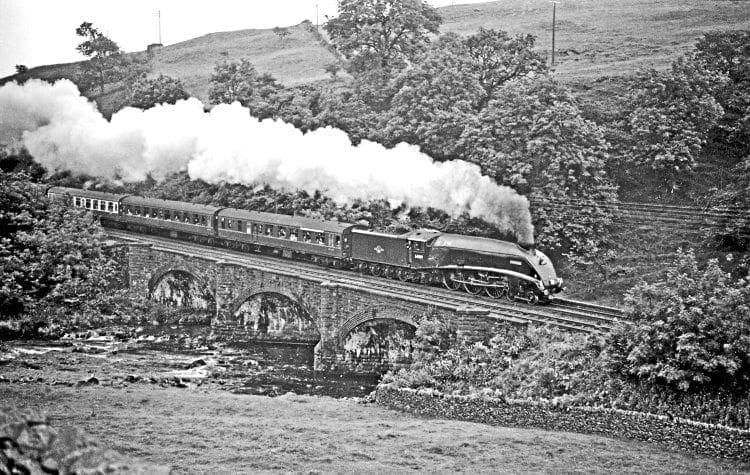
On November 5, Crewe South shed closed to steam along with Birkenhead. Steam became extremely rare on WCML express workings over any kind of distance. The end of BR steam really was getting closer and enthusiasts’ attentions were being focused on an ever-decreasing geographical area.
Birkenhead-based BR Standard 9F 2-10-0 No. 92203 headed the last steam-hauled ore train from Bidston dock to Shotton steelworks on November 6, after which the engine was purchased for preservation by wildlife artist and conservationist, David Shepherd, who had already purchased BR Standard 4MT 4-6-0 No. 75029 from Stoke shed. The two engines were stored at Crewe South alongside No. 4498 Sir Nigel Gresley,which had used the shed as its home base between railtour duties, but now faced an uncertain future. The closure of Birkenhead shed to steam did not signal the end of the 9Fs but the last few Crosti-boilered examples of the class were all withdrawn.

The end of steam in the West Riding and at Crewe left Carlisle’s still substantial allocation of Britannias with a much-reduced sphere of operation. Passenger duties either on the West Coast Main line over Shap or over the Settle & Carlisle line became very rare. There were only a handful of regular scheduled steam passenger workings, usually very short trains and these generally had ‘Black Five’ haulage while the Britannias were reduced mainly to freight and parcels trains.
Although November 1967 appeared to signal the end of steam at Crewe, this has very much turned out not to have been the case.
Crewe works became part of British Rail Engineering Ltd in 1969 but much of the site was cleared in a major redevelopment in the mid-1980s and BREL was privatised in 1989, eventually being taken over by the Canadian engineering company Bombardier in 2001. Part of the Crewe works site was used by Pete Waterman’s L&NWR company in later years with steam locomotive overhauls once again taking place. The nearby Crewe Heritage Centre has for many years provided locomotive servicing facilities for what is now a substantial number of main line steam railtours passing through the town.

More recently, Jeremy Hosking’s Locomotive Services Ltd, has taken over the former Crewe diesel depot south of the station and established a major steam locomotive overhaul facility. Time has shown that the autumn of 1967 did not mark the end of steam traction but sowed the seeds for the future development of the vibrant main line steam preservation scene that we enjoy 50 years later.
Read more News and Features in Heritage Railway – on sale now!
Archive enquiries to: Jane Skayman on 01507 529423 – [email protected]


